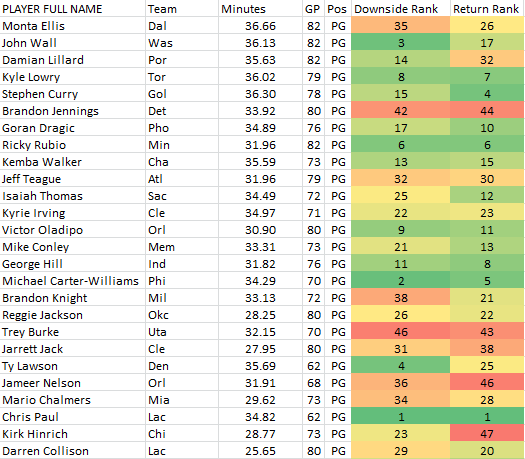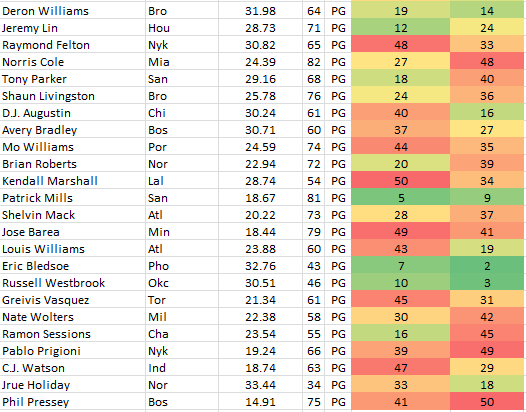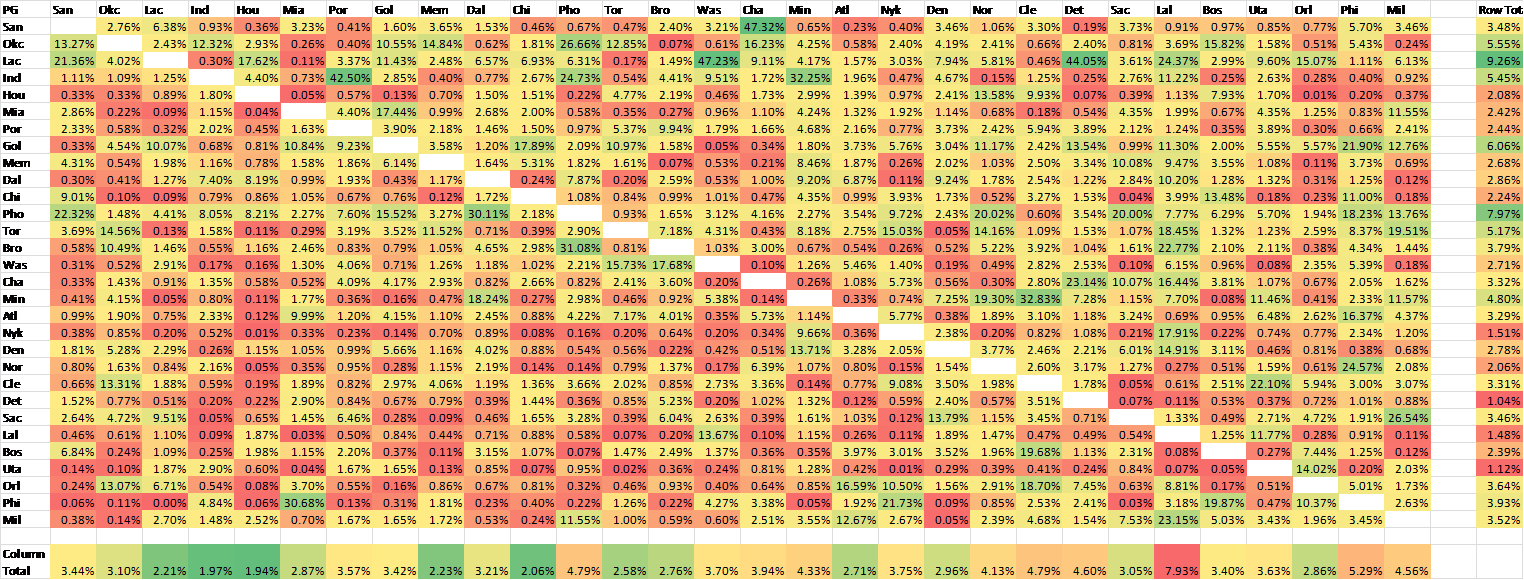As an avid basketball fan and statistician, I immerse myself with all things basketball which includes watching and reading popular media such as Grantland, FiveThirtyEight, and (my favorite for the added comedic reasons) Inside the NBA. In the past few weeks, I have heard the claim from basketball analysts on these channels that the point guard position is “loaded,” or the most competitive position to play across the league. While this certainly makes sense due to a point guard typically having to be the most skilled player on a team in terms of ball handling and sometimes shooting, I first wanted to take an analytic approach to see if these claims can be substantiated and find a way to somehow compare point guards against one another.
Quantifying performance is difficult to do in the NBA and there are various popular methods that seek to do so with PER (Player Efficiency Rating) probably the most widely used. For purposes of this analysis, however, I will use a method based solely on the logistic regressions (which is much less subjective than PER) and then look at the distributions of probability returns for positions predicted by this method for each player in the NBA. (These detailed results can be made available for anyone interested.)
Shown below are both the averages and standard deviations of the top 50 most played at each position for the 2013-2014 NBA Season. Before we look at the table though, we must first set some parameters to analyze the claims I mentioned before. When I think of “competitive,” I parallel this to the notion of standard deviation in statistics. Standard deviation is a measure of dispersion so I sought to test whether the point guard position was, in fact, the least dispersed (i.e. more competitive, less different) across the top 50 in the NBA.
From the chart shown, there is, in fact, some data justifying the aforementioned claims. For one, we can see how each position individually contributes to win/loss outcomes of games with the main reason for power forwards and centers being more valued due to their typically higher field goal percentages and rebound rates. Guards also typically take more difficult shots and thus accumulate detrimental stats like missed shots in a greater number than forwards and centers
The standard deviations shown seem to imply that guards have less variance in performances across the league and by a substantial amount. Even when accounting for the averages generated by the position, the ratios of return per unit of risk are much higher (thus implying less variation) for shooting and point guards than forwards and centers.
Positional mappings were obtained via basketball-reference.com and I sought to look at both shooting guards and point guards since there might be some debate whether a player is a 1 or 2 (Stephen Curry, Monta Ellis).
Finally, looking at only individual point guards through the scope of average returns and downside standard deviation (standard deviation accounting only for below average performance), the point guards ranked as follows.
These results seem to match in terms of how player performances are viewed at large. Players with larger downside ranks tend to have playing styles more apt for scoring which makes sense considering that they will have more “off” nights.
In general (and depending a team’s playing style), any team will almost surely want players like Chris Paul, Russell Westbrook, Eric Bledsoe, Michael Carter Williams, and Kyle Lowry who are ranked top ten in both metrics. However, the trade-offs become a bit murky when analyzing the rest of the chart.
A high returning but highly risky player (higher return rank, lower downside rank) such as Isaiah Thomas, Mike Conley, and Brandon Knight are to some extent valuable if the team is willing to accept the occasional below average performance from these players that on some nights can harm the team. Mike Conley is most often viewed as an underrated point guard which his high return (13th overall) suggests but perhaps his inconsistency towards downside performances (21st) is a reason why he isn’t given more due credit.
On the other hand, a lower returning player but with less consistent downside play (lower return rank than high downside rank) may be desirable if a team values steady production. Notable players categorized by these parameters include Damian Lillard, John Wall, and Ty Lawson. That is, you can typically bank on these players to at least hit their averages on a game to game basis. They are more rarely under-performing than other point guards in the league.
Finally, there are many on this list who fail to demonstrate a strength in any one of the criteria mentioned. They generally have low returns coupled with a high downside deviance. That’s not to say that they themselves are bad players, but rather are below average in comparison to the others shown.
I lastly wanted to show how team’s fared against one another across the regular season at the point guard position to gauge how well a particular style of point guard fared against another. For instance, we can actually test whether the Spurs do struggle against athletic types such as Russell Westbrook or Derrick Rose. The chart below shows the average game return mapped for particular games (Rows correspond to the “OWN” team, columns correspond to the Opposing team or “OPP”). We can see, in fact, that the Spurs did give up an above average performance to the Thunder in the regular season at the Point Guard slot (13.27%) that pretty much consists of the outputs of Westbrook and Reggie Jackson but they actually struggled more against the two-headed monster in Phoenix (Dragic and Bledsoe) and against the Clipper duo of Chris Paul and Darren Collison. This matrix proves extremely useful in analyzing which sets of players play well or poorly against the other and can actually be used in game planning.
The performance matrix above again demonstrates how dynamic and competitive the point guard position seems to be. Many teams with losing records will often fare well at the position against another more successful team.
Thus, when Kenny Smith of Inside the NBA argues that the point guard position is the most competitive, there are statistical justifications that this is indeed true. This analysis compares only the top 50 by minutes played (all point guards are accounted for in the performance matrix) but there are many players definitely capable of solid play given enough playing time. Rookies like Marcus Smart, Dante Exum and improved players like Darren Collison (and the return of Derrick Rose) will only add to this argument and make this position more competitive for years to come.

























